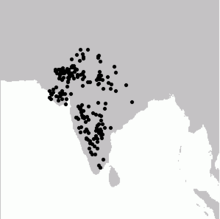Great Indian Bustard
| Great Indian bustard | |
|---|---|
 |
|
| At Naliya grasslands, Kutch, India | |
| Scientific classification | |
| Kingdom: | Animalia |
| Phylum: | Chordata |
| Class: | Aves |
| Order: | Otidiformes |
| Family: | Otididae |
| Genus: | Ardeotis |
| Species: | A. nigriceps |
| Binomial name | |
|
Ardeotis nigriceps (Vigors, 1831) |
|
 |
|
| Points where the species has been recorded. Once widespread, the species is today found mainly in central and western India. | |
| Synonyms | |
|
Choriotis nigriceps |
|
| Measurements | |||
|---|---|---|---|
| All populations | |||
| Length | 1,000–1,070 mm (39.4–42.1 in) | ||
| 760–830 mm (29.9–32.7 in) | |||
| Culmen | 85–95 mm (3.3–3.7 in) | ||
| Wing | 614–762 mm (24.2–30.0 in) | ||
| 460–540 mm (18.1–21.3 in) | |||
| Tail | 330–380 mm (13.0–15.0 in) | ||
| 245–270 mm (9.6–10.6 in) | |||
| Head | 170–180 mm (6.7–7.1 in) | ||
| 145–155 mm (5.7–6.1 in) | |||
| Weight | 8–14.5 kg (17.6–32.0 lb) | ||
| 2.5–6.75 kg (5.5–14.9 lb) | |||
| Foot | 275–300 mm (10.8–11.8 in) | ||
| 225–245 mm (8.9–9.6 in) | |||
Choriotis nigriceps
Eupodotis edwardsi
Otis nigriceps
The Great Indian Bustard (Ardeotis nigriceps) or Indian bustard is a bustard found in India and the adjoining regions of Pakistan. A large bird with a horizontal body and long bare legs, giving it an ostrich like appearance, this bird is among the heaviest of the flying birds. Once common on the dry plains of the Indian subcontinent, as few as 250 individuals were estimated in 2011 to survive and the species is critically endangered by hunting and loss of its habitat, which consists of large expanses of dry grassland and scrub. These birds are often found associated in the same habitat as blackbuck. It is protected under Wildlife Protection Act 1972 of India.
The great Indian bustard is a large ground bird with a height of about one metre. It is unmistakable with its black cap contrasting with the pale head and neck. The body is brownish with a black patch spotted in white. The male is deep sandy buff coloured and during the breeding season has a black breast band. The crown of the head is black and crested and is puffed up by displaying males. In the female which is smaller than the male, the head and neck are not pure white and the breast band is either rudimentary, broken or absent.
Among bustards, this species is smaller only than the Kori bustard and the great bustard in size. It is also the largest land bird in its native range. The great Indian bustard stands at about 1 m (3.3 ft) tall, having a somewhat long neck and quite long legs. The female as in most members of the bustard family are typically considerably smaller.
Males have a well-developed gular pouch which is inflated when calling during display and helps produce the deep resonant calls.
Abnormally leucistic or near albino birds have been reported.
This species was formerly widespread in India and Pakistan. The bustard is critically endangered in Pakistan primarily due to lack of protection and rampant hunting. A few birds have been detected in a September 2013 survey of the Cholistan Desert in Pakistan.
In India, the bird was historically found in Punjab, Haryana, Uttar Pradesh, Madhya Pradesh, Chhattisgarh, Orissa, Andhra Pradesh, Rajasthan, Gujarat, Maharashtra, Karnataka and Tamil Nadu. Today the bustard is restricted to isolated pockets in Andhra Pradesh, Gujarat, Karnataka, Maharashtra, Madhya Pradesh and Rajasthan (shared with Pakistan).
...
Wikipedia

